White sugar health effects
White sugar is pure sucrose. It is given the nickname "white death" because of the disastrous way it affects our health. The main reasons it is so harmful are:
1.- Demineralizing: Sugar is acidifying. In order to metabolize it, we need to resort to reserves of minerals of the body such as calcium, potassium and above all magnesium. These minerals buffer the acidity of the metabolites produced by sugar such as uric acid, oxalic acid, phytic, oxaloacetic, sulfuric, lactic, etc. We need 54 molecules of magnesium for each sucrose. It also increases the risk of kidney stones and gallstones, arthritis, rheumatism, etc. (1)
2.- Defenses: Ingestion of sugar weakens the immune system. The mobility of the white blood cells is affected: 30 minutes after the ingestion the activity of neutrophils decreases by 50%, which lasts for 5 hours. Lymphocytes are also reduce their activity. When we eliminate sugar from someone’s diet, the impact of recurrent respiratory and skin diseases diminishes considerably. (1)
3.- Dysbiosis: Sugar feeds undesirable gut bacteria, such as yeast bacteria: Candida or Escherichia coli, causing intestinal dysbiosis, which is the source of many diseases. It also promotes bacterial growth (streptococcus mutans) which is responsible for tooth decay.
4.- Fat: Excess sugar turns into fat reserves and increases the level of blood triglycerides.
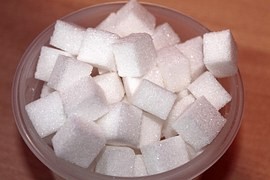 5.- Hyperglycemia/hypoglycemia cycles: Sugar consumption causes a sudden increase in blood glucose (hyperglycemia), resulting in excessive production of insulin which causes a drop in blood glucose below normal level (hypoglycemia). These repetitive cycles of hyperglicemia/hypoglycemia cause irritability, fatigue, migraines and sugar addiction. Finally, insulin resistance or diabetes may also be produced.
5.- Hyperglycemia/hypoglycemia cycles: Sugar consumption causes a sudden increase in blood glucose (hyperglycemia), resulting in excessive production of insulin which causes a drop in blood glucose below normal level (hypoglycemia). These repetitive cycles of hyperglicemia/hypoglycemia cause irritability, fatigue, migraines and sugar addiction. Finally, insulin resistance or diabetes may also be produced.6.- Glycation: Excess glucose bonds to proteins, forming glycated proteins, inhibiting the function of these proteins, and producing a high level of oxidative stress, which can damage the walls of blood vessels. This damage is repaired by platelets, white blood cells, cholesterol, collagen and other substances, forming the famous plaques, which are the cause of cardiovascular diseases. (8)
7.- IGF-1: Sugar stimulates the production of growth hormone IGF-1 in an excessive way, causing swelling and therefore, a number of diseases from cancer to migraine. (9)
8.- Addictive: Sugar stimulates the production of endorphins, the substances of well-being. But after a while the body decreases the production of endorphins when the same amount of sugar is ingested, or the receptors for endorphins decrease, so a greater amount of sugar will be needed in order to experience the same feeling of satisfaction. This creates a vicious cycle of increased sugar consumption and depression/euphoria, just as it happens in the case of alcohol and all other drugs. (10)
White sugar is commonly made from sugar cane or sugar beets. Through heating and mechanical and chemical processing, all vitamins, minerals, proteins, fats, enzymes and, indeed, every nutrient is removed until only the sugar (sucrose) remains.
Other sugars and syrups
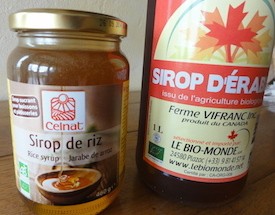 Maple syrup, rice syrup, kitul syrup, molasses, brown sugar, coconut and palm sugar.
Maple syrup, rice syrup, kitul syrup, molasses, brown sugar, coconut and palm sugar.These sugars undergoes highheating and adulteration in its processing and manufacture.
Besides being concentrated and deadened by high heat, maple syrup may also be contaminated by paraformaldehyde which is used during the tapping process to destroy bacteria. Formaldehyde compounds are poisonous and certainly should not be eaten in food. The sugars present in the syrup have become concentrated beyond their naturalstrength by the introduction of heat in its manufacture
Brown sugar is just white sugar colored with a little molasses and raw sugar is simply white sugar that may be missing one of the many refining steps that all sugars go through. Molasses are the chemicals and deranged nutrients that are a byproduct of sugar manufacture.
All these sugars and syrups do not pose the problem of demineralization that white sugar implies because they also provide minerals. However, in the studies it is not clear whether the amount is enough to meet the needs for their metabolism. Some nutritionists classify syrups and other sugars as acidifying, while others say agave syrup and brown sugar are not demineralizing.
Their composition is mainly sucrose in all except rice syrup which is mainly composed of maltose. Some of them also contain fructose and glucose in varying amounts.
However, their effect from other points of view is the same as that of sugar: they favour dysbiosis, weaken the immune system, and are rapidly absorbed with the consequent problem of hyperglycemia / hypoglycemia and diabetes, tooth decay, addiction, etc..
Honey
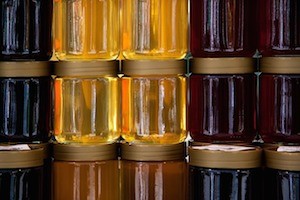 Unlike sugar and syrups, honey is composed of monosaccharides such as fructose and glucose, that is, in their simple state, so that they can be directly absorbed by the body. That is why diets that prohibit certain sugars and carbohydrates, such as the GAPS diet, do allow small amounts of honey.
Unlike sugar and syrups, honey is composed of monosaccharides such as fructose and glucose, that is, in their simple state, so that they can be directly absorbed by the body. That is why diets that prohibit certain sugars and carbohydrates, such as the GAPS diet, do allow small amounts of honey.Honey is said to have medicinal properties due to the antibiotic and healing substances that it is composed of. It is also rich in vitamins, minerals and Enzymes.
As a drawback, many nutritionists mention that when heating honey to over 40 ºC, not only its beneficial properties are destroyed, but even its components could degrade HMF, a toxic substance. So it is better not to use it for baking and to buy it in organic food shops where the honey has not been pasteurized. Also, if the bees are fed on flowers that are contaminated with pesticides, the honey will be a concentrate of these chemicals.
As it will be discussed subsequently, HMF can also be generated by heating all types of sugars.
Fructose, fruit syrups and agave syrup
Fructose is highly controversial, especially in countries like the USA, where the use of high-fructose corn syrup (HFCS) is widespread, being one of the main causes of obesity in the country.
Fruit and vegetables contain fructose along with fiber, pectin, minerals, vitamins, Enzymes, etc. The problem is when we consume pure and refined fructose in much higher doses than it is contained in fruit. (2)
Fructose follows a different metabolism process from glucose. It does not need the insulin production, but goes directly to the liver where 50% is metabolized into glucose, 25% into lactate, 17% into CO2, 15% into glycogen and the remainder (2-3%) is converted to fat (fatty acids, cholesterol and triglycerides), which are also components of our cells, and in case they are not required, they are stored. The residue of the metabolism is uric acid.
Fruit syrups and agave syrup are concentrated fructose. Agave syrup goes through a similar chemical extraction procedure to which corn is subjected to in order to extract HFCS. These syrups have a high fructose content, along with some amount of sucrose. Like their other sugar substitute counterparts, they are not as harmful as refined fructose, however, they also cause the same kind of problems.
While fructose contained in fruit does not cause any major problems, unless someone has an intolerance to it, in the end the effects of refined fructose and concentrated fructose on health are almost identical to sugar: obesity, insulin resistance, cardiovascular diseases, etc.
Xylitol, sorbitol, maltitol and yacon syrup
Maltitol, sorbitol and xylitol are sugar alcohols. Tey are not absorbed by the body, so they have a negligible glycemic index. Antibiotic properties are also attributed to xylitol, moreover, it does not feed any undesirable bacteria.
Yacon syrup is mainly composed of fructo-oligosaccharides – which is a sugar that can not be absorbed – in addition to sucrose, fructose and glucose in smaller amounts.
Most people do not tolerate this type of sugar because it irritates the intestines and has a laxative effect when a certain amount (which depends on each person) is exceeded. There are people who do not even tolerate half a teaspoon.
Artificial sweeteners
 Aspartame, saccharin, sucralose, cyclamate, neotame, etc.
Aspartame, saccharin, sucralose, cyclamate, neotame, etc.Artificial sweeteners are the product of different chemical compounds artificially produced in laboratories.
Aspartame produces methanol as a result of the metabolism performed by the body, so it is the most controversial sweetener. It is associated with many diseases: migraine, memory loss, dizziness, nausea, convulsions, numbness, muscle spasms, itching , depression, fatigue, irritability, vision problems, heart palpitations, breathing difficulties, anxiety, joint pain, fatigue, depression, epilepsy, chronic fatigue, etc.
In addition, there is evidence that these sweeteners do not help you lose weight, but quite the opposite.
Stevia
Refined stevia is also an artificial sweetener. It is only natural as a plant (herb), but its texture and taste remind many people of licorice, which is not very palatable when used for baking purposes. However, the stevia plant seems to be one of the best choices as a sweetener for its zero calorie content and completely natural sources.
Sugars in baking
When glucose or fructose are heated in the presence of some acid, it leads to the Maillard reaction and a molecule called hydroxymethylfurfural (HMF) is produced, which is toxic. Healthy people can easily remove it through the urine, however, some studies classified this substance as carcinogenic. (5)
The allowed HMF limit for honey for sale is 40 mg / kg. For example, it takes about 2 hours at 80ºC to raise the HMF in honey up to 30 mg / kg. (6) Even in nougat, which is roasted almonds with honey, HMF does not reach the maximum level allowed.
The amount of HMF is greater in baked goods when sweeteners with free glucose and fructose are used, rather than in those where they are found in the form of sucrose. For example, cookies made with sucrose contain about 9.9 mg/kg, while cookies made with glucose and fructose contain about 35 mg/kg. The highest concentration of HMF in sweeteners is found in grape syrup (up to 11000 mg / kg). (7)
The amount of HMF produced by heating the usual sweeteners is well below the amount that is contained in bread (151.2 mg/kg), particularly when it is toasted (up to 2024.8 mg/kg), or in coffee (up to 2900 mg/kg). A surprising fact is that dried fruit naturally contains a lot of HMF, such as dates contain about 1000 mg/kg and plums about 2200 mg/kg!
As to the result of different sweeteners in baking, keep in mind that rice syrup becomes liquid when heated, so it is not recommended for cookies, cakes, etc.
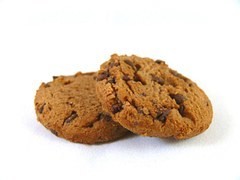
For the preparation of cookies, sugars work best. Kitul syrup is particularly suitable if we want to replace the egg when baking cookies.
Honey and dried fruit are the only sweeteners allowed in the GAPS diet. When honey is subjected to high heat, the water evaporates from it and consequently it crystallizes and hardens, and therefore it is not very suitable for baking biscuits and cakes.
Conclusion
The healthiest sweeteners are honey and fresh fruit when not heated or baked in the oven. In the case of heating or baking, from the viewpoint of toxicity, it seems that sugars that have a high content of sucrose, such as brown sugar or maple syrup, are the most suitable ones. However, we must consider the disadvantages to health of sucrose intake: demineralization, intestinal dysbiosis, cycles of hyperglycemia and hypoglycemia, weakness of the immune system, tooth decay, etc. Consequently the best option is to make sweets that do not need to be heated or baked. On this other page you can find some recipes of raw desserts.
Bibliography
(1) “L’équilibre glycémique”, Jacques Fontaine
(2) “Sugar May Be Bad, But This Sweetener Called Fructose Is Far More Deadly” , Dr. Mercola
(3) “Ask Chris: Is Fructose Really That Bad?” , Chris Kesser
(4) http://en.wikipedia.org/wiki/Hydroxymethylfurfural
(5) http://www.airborne.co.nz/hmf.shtml
(6) “Acrylamide and 5-hydroxymethylfurfural (HMF): A review on metabolism, toxicity, occurrence in food and mitigation strategies”, LWT - Food Science and Technology
(7) 1“5-Hydroxymethyl-2-Furfural (HMF) – Heat-Induced Formation, Occurrence in Food and Biotransformation – a Review” , Pol. J. Food Nutr. Sci., 2013, Vol. 63, No. 4, pp. 207-225
(8) “Put your heart in your mouth”, Dr. Campbell-McBride
(9) “Anti-Cancer Nutrition: Sugar and Carbohydrates 101”, Integrative Oncology Essentials
(10) “Processed Sugar Can Cause Addiction and Depression”
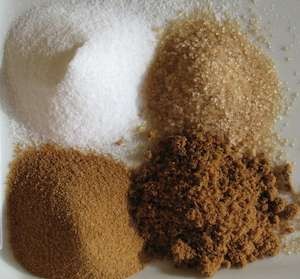 It is a well-known fact that refined sugar is unhealthy: it causes tooth decay, obesity, diabetes, some studies also relate it to cardiovascular, rheumatological, neurological diseases and even to cancer. So it is better to use healthier alternatives to sweeten desserts.
It is a well-known fact that refined sugar is unhealthy: it causes tooth decay, obesity, diabetes, some studies also relate it to cardiovascular, rheumatological, neurological diseases and even to cancer. So it is better to use healthier alternatives to sweeten desserts.











